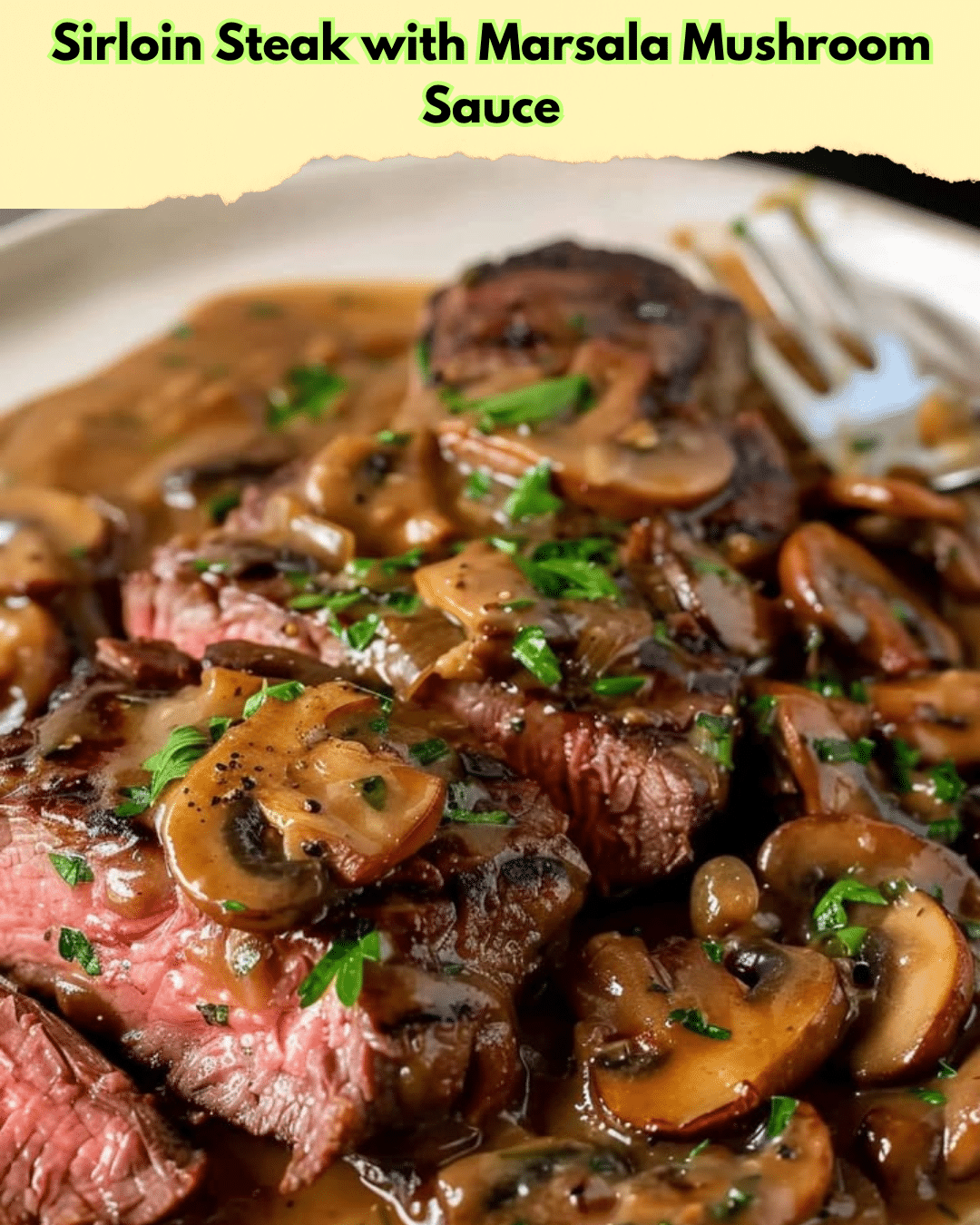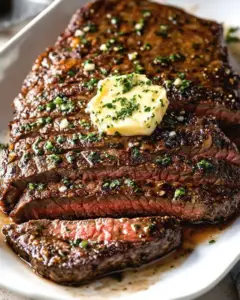Sirloin Steak with Marsala Mushroom Sauce: A Gourmet Delight
Indulge in the decadent and savory taste of our Sirloin Steak with Marsala Mushroom Sauce, a delicacy that marries tender meat with the rich, earthy flavors of mushrooms and marsala wine. This dish is a true epitome of fine dining, bringing the restaurant experience right to your home kitchen. Imagine the juicy, perfectly cooked sirloin mingling with the buttery mushroom sauce, making each bite a celebration of flavors. This sirloin steak recipe is perfect for those special occasions when you want to impress your guests or simply elevate a weeknight dinner.
The robust sirloin steak is seared to perfection, showcasing a beautiful golden-brown crust that locks in all the juices. The Marsala mushroom sauce, with its deep aromatic notes, complements the steak’s succulent texture, creating a harmonious balance. This dish not only satisfies your cravings but also offers an exquisite sensory experience, from the inviting aroma to the visually appealing presentation. Whether you’re a steak enthusiast or a mushroom lover, this recipe is bound to become a staple in your culinary repertoire.
Quick Recipe Highlights
- Flavor Profile: The Sirloin Steak with Marsala Mushroom Sauce boasts a rich and savory flavor with a hint of sweetness from the Marsala wine, complemented by the umami notes of mushrooms.
- Texture: Enjoy the tender and juicy sirloin steak, paired with the creamy and silky texture of the mushroom sauce.
- Aroma: Experience the enticing aroma of seared steak combined with fragrant mushrooms and the unique scent of Marsala wine.
- Visual Appeal: The golden-brown crust of the steak contrasts beautifully with the creamy mushroom sauce, creating a restaurant-quality presentation.
- Skill Level Needed: Moderate; basic steak-searing techniques and sauce preparation skills are required to master this dish.
- Special Equipment: A heavy-duty skillet or cast-iron pan is recommended for achieving the perfect sear on the steak.
Recipe Overview
- Difficulty Level: Despite its gourmet appearance, this dish falls under moderate difficulty. The main challenge lies in achieving the perfect sear on the steak and balancing the flavors of the mushroom sauce.
- Category: Main Course, Gourmet, Special Occasion
- Cuisine: This dish draws from classic Italian and American steakhouse traditions, offering a delightful fusion of flavors.
- Cost: Approximately moderate; the high-quality steak is balanced by the more affordable ingredients for the sauce.
- Season: Ideal for autumn and winter, when warm, rich flavors are most comforting.
- Occasion: Perfect for romantic dinners, celebrations, or impressing guests with a sophisticated meal.
Why You’ll Love This Recipe
The sirloin steak provides a hearty and satisfying meal with its robust flavor and tender texture. It’s a dish that appeals to those who appreciate a perfectly cooked steak and the deep flavor profiles it can offer. The Marsala mushroom sauce adds a sophisticated touch, enhancing the steak with a complex blend of savory and slightly sweet notes that mingle beautifully with the meat.
Convenience is a significant advantage of this recipe. It requires minimal preparation and cook time, making it accessible even on busier days. The ingredients are straightforward, and the techniques involved, while refined, are not overly complicated, making this a go-to dish for both novice and experienced cooks.
From a nutritional standpoint, this recipe offers a good balance of protein and healthy fats. Mushrooms and Marsala wine add essential nutrients and antioxidants to the dish, making it a healthy choice that doesn’t compromise on taste.
Socially, the Sirloin Steak with Marsala Mushroom Sauce is a conversation starter. Its unique flavor combination and gourmet presentation make it perfect for dining experiences that aim to impress. It’s a versatile dish that fits well into various settings, from casual family dinners to elegant gatherings.
Cost-effectiveness is another reason to love this recipe. By using ingredients strategically, you can create a luxurious meal without breaking the bank. While sirloin is a premium cut, the other components of the sauce are budget-friendly, making it an affordable option for special occasions.
Historical Background and Cultural Significance
The origin of sirloin steak can be traced back to the rich traditions of European butchery, where specific steak cuts were developed to enhance flavor and texture. Over the years, the sirloin has been celebrated for its balance of marbling and lean meat, making it a popular choice in steakhouses worldwide.
Marsala wine hails from the Sicilian region of Italy, where it has been crafted since the late 18th century. Known for its robust and slightly sweet flavor, Marsala wine has become a key ingredient in Italian cuisine, particularly in sauces that are rich and aromatic.
The evolution of this recipe has seen the integration of mushrooms, a versatile addition that amplifies the umami factor in the dish. Mushrooms have long been used in cooking for their ability to enrich flavors, particularly in meat dishes.
Regional variations of this dish exist, with different areas adapting the sauce or seasoning to match local tastes and available ingredients. From French-inspired shallot additions to Dutch caramelized onion variations, the dish offers a spectrum of flavors while maintaining its core identity.
Ingredient Deep Dive
Sirloin steak is prized for its tenderness and flavor, offering a perfect balance for those who love the taste of beef without overwhelming fattiness. Its history in culinary arts dates back centuries, with butchers perfecting the cut to maximize juiciness and taste.
Nutritionally, sirloin is an excellent source of high-quality protein and essential amino acids needed for muscle repair and growth. Select steaks with good marbling for the best flavor profile, and store them in the coldest part of your fridge, tightly wrapped to prevent any exposure to air.
Marsala wine, with its distinct Italian roots, adds a sweet yet savory depth to dishes. It serves as a culinary bridge to the addition of other ingredients like mushrooms, which enhance the recipe’s complexity. Choose a Marsala that complements your taste preferences, whether sweet or dry, according to the dish’s desired outcome.
For mushrooms, nutritional benefits include a rich source of vitamins B and D, bolstering immune and bone health. Fresh mushrooms should be firm and dry; store them in a paper bag in the refrigerator to keep them from becoming slimy.
Common Mistakes to Avoid
- Overcooking the steak is a common mistake that results in a dry and tough texture. Aim for a medium-rare finish to preserve juiciness.
- Skipping the rest period leads to juicy loss; ensure the steak rests for at least 5 minutes before slicing.
- Using cold steak results in uneven cooking. Allow the steak to come to room temperature before searing.
- Overcrowding the pan inhibits browning. Ensure ample space for each steak to caramelize properly.
- Neglecting seasoning the steak before cooking can lead to a bland result; don’t skimp on salt and pepper.
- Adding mushrooms too early can make them soggy. Instead, sauté separately and add to the sauce at the end.
- Using inferior Marsala impacts sauce flavor. Opt for a quality option for the best results.
- Ignoring the sauce thickness can lead to an unappetizing result. Monitor and adjust consistency as needed.
- Not tasting as you go can result in imbalanced flavors. Sample the sauce during cooking to ensure it meets your taste.
- Rushing the sauce can prevent flavor development. Allow time for the ingredients to meld together thoroughly.
Essential Techniques
Searing the steak is crucial for creating a flavorful crust. Master this technique by using a hot pan with a bit of oil until it begins to smoke. Place the steak without moving it for at least 2-3 minutes per side, ensuring the desired crust forms.
Creating a luscious sauce is vital for this recipe. Begin with sautéing onions and garlic until fragrant, deglazing with Marsala wine, and reducing the mixture to concentrate flavors.
Pay attention to the sauce’s consistency. It should coat the back of a spoon without being too runny or overly thick. Adjust by adding stock or reducing further.
Remember to balance the sauce’s acidity and sweetness. Taste and adjust seasonings such as salt or a touch of lemon juice to achieve a harmonious blend.
Pro Tips for Perfect Sirloin Steak with Marsala Mushroom Sauce
Choose the best quality sirloin steak you can find, as the meat’s quality significantly impacts the final result. Aim for well-marbled cuts with a deep red color.
Allow the steak to come to room temperature before cooking to ensure even heat distribution and reduce cooking time.
Utilize a meat thermometer to check for doneness, targeting around 130°F (54°C) for medium-rare.
Deglaze the pan with Marsala wine to pick up all the flavorful bits left from searing the steak, infusing the sauce with extra depth.
When making the sauce, use heavy cream for the richest consistency, ensuring a smooth and velvety texture.
Experiment with different types of mushrooms for varied flavor profiles and textures. Shiitakes or chanterelles can offer unique tastes compared to traditional button mushrooms.
Variations and Adaptations
Explore regional variations by experimenting with different herbs such as rosemary or thyme to bring a personalized touch to the marinade.
For seasonal changes, incorporate vegetables like asparagus or peas in the spring to add freshness and color to your plate.
Adapting to dietary needs, consider using a gluten-free flour as a thickener in the sauce to accommodate gluten-sensitive diners.
Experiment with additional flavors, like a splash of balsamic vinegar for added acidity or a handful of toasted walnuts for a nutty contrast.
Modify the texture by substituting cream with coconut cream for a dairy-free option, providing a lush sauce consistency while maintaining a twist.
Presentation alternatives including thinly slicing the steak for serving may appeal to diners favoring smaller portions or appreciating meticulously arranged plating.
Serving and Presentation Guide
Plate the dish by slicing the steak against the grain, fanning the pieces out across the plate for an elegant presentation.
Garnishing with freshly chopped parsley or chives adds a pop of color and a subtle herbal note that enhances the dish’s overall appeal.
Serve alongside traditional accompaniments such as roasted potatoes or a simple green salad to balance the rich flavors of the steak and sauce.
For a modern twist, present the steak on a warm slate or wooden board, accentuating a rustic yet sophisticated charm.
Consider serving at a slightly warmer temperature to enhance the aroma, encouraging guests to enjoy the dish at its peak flavor.
Portion control is essential for an optimal dish experience; aim for individual steak servings, allowing guests to tailor their portions as desired.
Wine and Beverage Pairing
Pair with a bold red wine such as Cabernet Sauvignon or Syrah, matching the steak’s rich flavors and enhancing the wine’s fruity notes.
For a non-alcoholic option, consider a pomegranate juice spritzer, which provides a refreshing and slightly sweet contrast to the dish.
Coffee lovers may find the pairing of Ethiopian Yirgacheffe coffee intriguing, as its floral and wine-like characteristics complement the sauce.
Temperature considerations include serving red wine at room temperature to maximize its bouquet and pairing potential.
Suggested serving glasses should be large and wide-mouthed, allowing the wine to breathe and release its aromatic compounds.
Storage and Shelf Life
Store leftover steak in an airtight container in the refrigerator for up to three days to maintain its tenderness and flavor.
Savor the dish freshest when consumed within the first day after preparation, as prolonged storage may alter texture and aroma profiles.
Choose a sturdy, BPA-free container that can withstand repeated use and maintain the optimal quality of the dish over time.
Signs of spoilage include off-putting odors or alterations in color, indicating that the steak or sauce may no longer be safe to consume.
Reheating instructions involve gently warming the dish in a skillet over low heat to retain moisture and prevent drying out.
Freezing the Marsala mushroom sauce separately is an option, preserving it for up to three months and allowing for on-demand use.
Make Ahead Strategies
Prepare the sauce in advance to streamline mealtime organization, warming it gently before serving for best results.
Store the sauce in individual portions, facilitating easy reheating and minimizing leftover waste for subsequent meals.
Plan a prep timeline that accounts for marinating time for added flavor or incorporates side dishes that complement the core recipe.
Assess the quality impact when reheating the steak, avoiding overcooking by removing from heat once reaching preferred internal temperature.
Boost fresher elements by garnishing with recently chopped herbs before serving, preserving brightness and enhancing the dish’s complexity.
Scaling Instructions
Halve the recipe by adjusting ingredient quantities proportionately, ensuring even distribution and a consistent flavor experience.
For larger gatherings, doubling the recipe necessitates using multiple pans to maintain ideal sear and cooking times.
Equipment adjustments may involve selecting heavier cookware with even heat distribution, especially when handling more considerable quantities.
Recognize timing modifications required to both prep and cook when altering the recipe scale while maintaining dish integrity.
Consider pre-portioned storage solutions for leftovers, using vacuum sealing to kickstarts preservation efforts for convenient future use.
Nutritional Deep Dive
This dish’s macro breakdown provides a valuable balance of protein and fats, largely sourced from the sirloin steak and mushroom sauce foundation.
Micronutrient analysis reveals a wealth of essential vitamins and minerals, augmenting dietary variety with vitamin B-rich mushrooms and antioxidant-rich Marsala wine.
Health benefits extend into muscle recovery and sustained energy levels thanks to the ample protein derived from premium meat cuts.
Dietary considerations like adequate portion control support nutritional boundaries, allowing health-minded diners to optimize nutrient intake without excess.
Incorporate weight management tips by choosing leaner gravy or opting for half-house servings to practice mindful dining without sacrificing taste.
Dietary Adaptations
Gluten-free variations may involve swapping traditional flour for cornstarch or alternative gluten-free thickening agents in the mushroom sauce.
For dairy-free needs, substitute heavy cream with oat or almond creamer, preserving flavor while adjusting recipe structure.
Vegan adaptations include using seitan or tofu steaks and nutritional yeast for the sauce to mimic the creamy consistency without any animal products.
Low-carb adjustments center on decreasing carbs in side dishes and replacing potatoes with Green or leafy vegetables for a complete meal.
Keto considerations prioritize ingredient lean cuts of beef, premium butter, and minimal carbs to meet desired macronutrient ratios.
Paleo-friendly sirloin steak transforms using bone broth and coconut aminos, remaining free from processed foods in ingredient lists.
Low-FODMAP tweaks mirror vegetable swaps, ensuring a comfortable dining experience without digestive disturbances common with certain foods.
Troubleshooting Guide
Address texture issues through careful monitoring of meat temperature, gauging doneness promptly without dry or overcooked results.
Optimize flavor balance by sampling the sauce midway through preparation, consulting tastes from multiple pallets for consistent seasoning enjoyment.
Temperatures influence roasted beef flavor intensities, resolved by thermometer use and careful monitoring of internal steak temps.
Overcoming equipment challenges involves selecting the right cookware, ensuring tools are calibrated and maintained for premium cooking outcomes.
Ingredient substitutions present adaptation opportunities across dietary needs by embracing almond or coconut alternatives to traditional counterparts.
Timing concerns stress the importance of executing a cooking plan, measuring and allotting prep and cook times accurately for smooth processing.
Recipe Success Stories
Feedback from the community highlights rave reviews, celebrating Sirloin Steak with Marsala Mushroom Sauce’s newfound popularity as a regular dining staple.
Reader suggestions unravel creative culinary avenues, from garlic-infused broths to truffle oil inspiration that enhances texture and flavor leadership.
Unique adaptation stories populate social media posts, where avocado derivatives or temperate spin-offs captivate home dining audiences.
Pioneering photography often whispers tips and tricks of the creative culinary experience, showcasing plate arrangements establishing award-winning visual artistry.
Frequently Asked Questions
Q1: Can I substitute chicken for the sirloin steak?
A1: Yes, chicken breasts or thighs can be used. Adjust the cooking time as they may cook faster than beef.
Q2: What’s a good vegetarian option for this recipe?
A2: Consider using hearty vegetables like portobello mushrooms or eggplant slices as a steak substitute to soak up the sauce flavors.
Q3: Can I use non-alcoholic wine for the sauce?
A3: Yes, a non-alcoholic Marsala wine or even a broth with some added grape juice can substitute Marsala wine.
Q4: How do I store leftover sauce?
A4: Store leftover sauce in an airtight container, refrigerating it up to three days or freezing for longer-term storage.
Q5: Can this dish be made in a slow cooker?
A5: While the sauce can develop in a slow cooker, sear the steak separately to achieve the desired crust before combining it with the sauce.
Q6: Is it important to rest the steak?
A6: Absolutely, allowing the steak to rest ensures juices redistribute, resulting in a tender and flavorful cut upon slicing.
Q7: Are there any recipe variations for different mushroom types?
A7: Feel free to experiment with exotic mushrooms like shiitake or chanterelles for varied textures and flavors.
Q8: How do I prevent my sauce from becoming too thick?
A8: Gradually add stock or Marsala while cooking, adjusting for the right consistency and ensuring frequent stirring.
Q9: Can I use frozen steak?
A9: It’s preferable to use fresh steak, but if necessary, ensure the frozen steak is fully thawed in the fridge before cooking.
Q10: What side dishes go well with this recipe?
A10: Pair with mashed potatoes, a crisp green salad, or roasted vegetables for a balanced meal, harmonizing flavors and textures.
Additional Resources
Explore related recipes such as Beef Wellington or Coq au Vin for further meaty adventures in gourmet cuisine.
Technique guides detailing essential France culinary skills, such as sauce reductions or breadcrust searing, aid in perfecting this dish’s execution.
Dive into ingredient information for detailed guides on selecting the best cuts or varieties, distinguishing key characteristics and quality assurance.
Discover equipment recommendations and tools designed to elevate culinary creations through precise control and ideal preparation results.
Adapt seasonal variations by embracing all seasons’ offerings, crafting suitable substitutes or incorporating timely ingredients into favorite dishes.
Print
Sirloin Steak with Marsala Mushroom Sauce
Description
A delicious sirloin steak paired with a rich Marsala mushroom sauce, perfect for a sophisticated dinner.
Ingredients
For the Crust:
- 2 sirloin steaks
- 1 cup sliced button mushrooms
- 1/2 cup Marsala wine
- 1/4 cup beef broth
- 2 tablespoons olive oil
- 1 tablespoon butter
- 2 cloves garlic, minced
- Salt and pepper to taste
Instructions
1. Prepare the Crust:
- Season the steaks with salt and pepper on both sides.
- In a skillet over medium-high heat, heat the olive oil and sear the steaks for 4-5 minutes on each side until desired doneness is reached. Remove from the skillet and set aside.
- In the same skillet, add butter and garlic, sautéing until fragrant. Add mushrooms and cook until softened. Pour in Marsala wine and beef broth, simmer until the sauce thickens. Serve sauce over the steaks.
Notes
You can customize the seasonings to taste.




